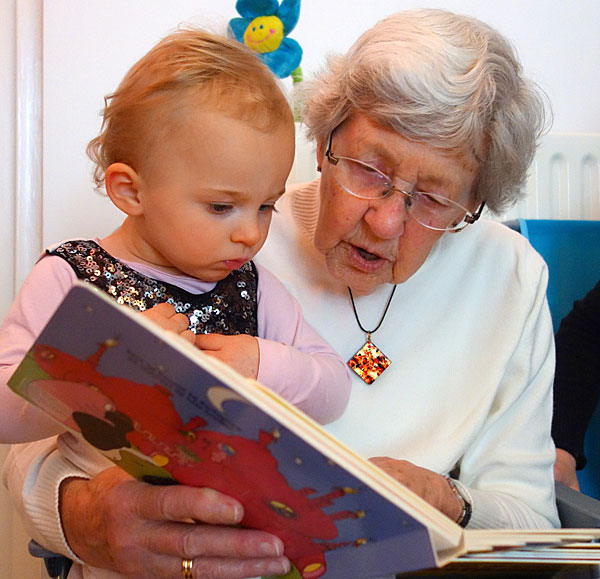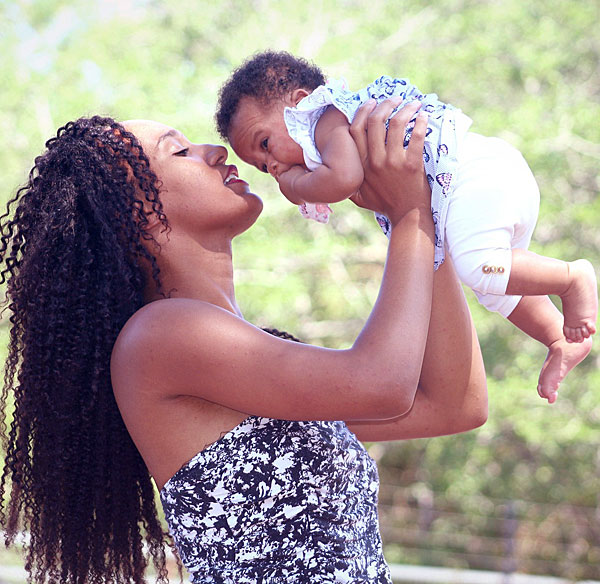For Young Children, Talking is Teaching
By Allison Wilson
Assistant Professor of Early Childhood Education
UM Center for Children, Families and Workforce Development
 MISSOULA – During the earliest years, it’s not the number of costly toys or alphabet flashcards a child has that is of utmost importance but rather something that is completely free: talking. Language is central to all strands of a child’s development, including attachment, early literacy, early math and social-emotional development. Of course, words aren’t the only way children communicate. Very young children point, use body language, cry, or make eye contact to give us messages. Recognizing and positively reinforcing these precursors to language is essential for more advanced language to come.
MISSOULA – During the earliest years, it’s not the number of costly toys or alphabet flashcards a child has that is of utmost importance but rather something that is completely free: talking. Language is central to all strands of a child’s development, including attachment, early literacy, early math and social-emotional development. Of course, words aren’t the only way children communicate. Very young children point, use body language, cry, or make eye contact to give us messages. Recognizing and positively reinforcing these precursors to language is essential for more advanced language to come.
World-renowned pediatrician Dr. T. Berry Brazelton and child psychologist Dr. Joshua Sparrow have researched and written abundantly about the invaluable nature of bonding between parents and their children. The positive relationship formed through quality moments cuddling with a caregiver, laughing or being comforted increases a baby’s brain growth, sense of security and attachment. When language is nurtured out of a secure attachment through loving adult-child exchanges, very young children learn to use early language as a tool to interact with others, practice self-control and explore their surroundings.
The research is clear – talking is teaching. Parental responses to infant babbling can influence a child’s language development. Infants whose caregivers respond to what they think their babies are saying show an increase in advanced language sounds. However, research suggests by the time children are 2 years old, there is already a six-month gap in language understanding between children from higher-income and lower-income families, and by age four, the average child in a lower-income family might have 30 million fewer words of cumulative experience than the average child in a high-income family.
Such disparity remains apparent throughout the school years and is linked with later academic successes. Building from this research, more recent evidence has shown conversational turns to have more brain-building power than adult words alone, and without income as a predictor. Conversational turns are simple back-and-forth exchanges between a child and an adult, like in a game of tennis or ping pong. Children whose caregivers talk with them are more likely to use language with confidence and to grow larger vocabularies at younger ages. Such research provides an encouraging platform to empower parents and caregivers, especially those with limited resources, to realize how much they have the ability to benefit their child’s life by talking, reading and singing to them every day. But how do new realities of social distancing and wearing face masks impact a child’s environment of quality relationships and language-rich interactions?
Very young children learning how to use communication are especially impacted, and even more so are young children with hearing loss. A huge part of language development in infancy through preschool includes what is referred to as social referencing. Children gain a lot of information from a face that is laughing, fearful, angry or smiling. Young children whose caregivers are masked will miss some of these visual cues and possibly even have some trouble sorting out who goes with which voice when in groups. However, there are opportunities for caregivers to be creative and more intentional during their interactions, helping young children take full advantage of the visual information they receive.
An important strategy for all caregivers is to obtain a child’s full attention before starting to talk by saying their name, making eye contact and, if possible, moving down to the child’s level and avoiding talk from far across a room. Caregivers also can intentionally exaggerate gestures, tone of voice and, as much as possible, aim to convey messages with their eyes while speaking. Making explicit comments to draw children’s attention to their feelings by saying things like, “Look how happy my eyes looks, or look how surprised I am, my eyes are so wide!” also will be helpful, as will slowing down speech.
Caregivers who regularly interact with young children outside the home in childcare and classroom settings can consider consistency with their appearance by wearing the same hairstyle, characteristic clothing, personalized masks or even a large badge with a nonmasked photograph. They may also create a playful game of helping children find ways of communicating with their hands and bodies, like charades!
 With or without masks, everyday routines offer many novel opportunities to embed quality language-rich interactions. One of the simplest strategies is for caregivers to pretend to be broadcasters by giving play-by-plays. For example, when it’s time for a bath, a caregiver can describe and label what they see and what they are doing: “It’s time to get cleaned up … I’m picking you up … We’re walking to the tub … Let’s count how many steps … I’m starting the water … The water feels warm … Let’s make some bubbles.” They can also describe what children are doing: “You have the red car … You’re driving it slowly around the chair.”
With or without masks, everyday routines offer many novel opportunities to embed quality language-rich interactions. One of the simplest strategies is for caregivers to pretend to be broadcasters by giving play-by-plays. For example, when it’s time for a bath, a caregiver can describe and label what they see and what they are doing: “It’s time to get cleaned up … I’m picking you up … We’re walking to the tub … Let’s count how many steps … I’m starting the water … The water feels warm … Let’s make some bubbles.” They can also describe what children are doing: “You have the red car … You’re driving it slowly around the chair.”
Another fun way of encouraging language is to pretend to be forgetful during everyday familiar routines like getting dressed, cleaning up or while singing songs. Caregivers can be silly and put their socks on before their shoes or exaggerate putting a dirty dish in the clean cabinet as an opportunity for young children to catch and correct the routine. During a familiar song a caregiver might pause to let the child fill in the words. Outside of the home environment, community settings offer meaningful language opportunities. Grocery stores, car rides, bus stops, libraries, laundromats, waiting rooms and parks are familiar environments for children. Playing a simple game like “I Spy” creates a language-rich opportunity for children to engage by practicing their communication skills. The most powerful types of conversations are those that are playful and anchored in responsive interactions that are emotionally satisfying for a child but also for the adult who loves them.
While these are stressful times for everyone, these early years are a critical period for development, and every moment counts. Learning language should be fun, and everyone has a role to play. Young children develop in an environment of relationships. Family friends, neighbors, pediatricians, grocery store clerks, librarians, bus drivers, bank tellers and faith leaders are valuable assets to a child’s language development. These individuals can promote and reinforce language-rich opportunities for positive engagement throughout community settings frequented by young children and families. These everyday language and learning opportunities are small but meaningful moments of interaction that have a big impact on a child’s life. When young children and families thrive, a community thrives.
Note: This article draws on the research of Berry Brazelton, Joshua Sparrow, Julie Gros-Louis, Meredith West, Andrew King, B. Hart, T. Risely, Marchman Fernald, A. Wisleder, D.K. Dickinson, R.M. Golinkoff, K. Hirsh-Pasek, P.O. Tabors, C.E. Snow, M.S. Burns, P. Griffin and others.
###
Contact: Haley Eakin, research analyst, UM Center for Children, Familes and Workforce Development, haley.eakin@mso.umt.edu.